“I love not Man the less, but Nature more.” - George Gordon Byron
The ocean covers 70 percent of the Earth’s surface and 97 percent of Earth’s water is found in this ocean. The Indian Ocean covers 14.4% of the earth’s total surface area.
More than 15,000 tonnes of plastic is generated in India every day, of which 6,000 tonnes remain uncollected and littered. So where does this plastic go?
India pumps 0.6 tonnes of plastic into the Indian Ocean and this plastic swirls across oceans and continents via powerful currents. The result: the formation of a huge patch of garbage called the Great Pacific Garbage Patch, which has been growing over the years. The main component of this garbage is plastic.
Plastic that enters the ocean affects the entire food chain, from the marine ecosystem to humans. It absorbs dangerous pollutants like PCBs, DDT and PAH. These chemicals are highly toxic and have a wide range of chronic effects, including endocrine disruption and cancer-causing mutations. Fish and other marine animals mistake this floating plastic for food and when it enters their system, the toxins are absorbed into their body and passed up through the food chain.
There are four sizes of plastic in our ocean: small microplastics, large microplastics, meso plastics and macro plastics that are ingested by the marine ecosystem. The remaining disposed garbage gets thrown back on the shores marring the coastline and is an eyesore for everyone.
The accessibility of our coastlines is reducing every day because of the heaps of garbage, including plastic, which floats ashore. One such area is the coast of Mumbai.
The coastal city’s edge is meant to be a social space for city dwellers to take a breather. Unfortunately, the NIMBY (Not In My Backyard) syndrome has made the beaches a spot for the city’s garbage to stagnate, further reducing accessibility.
Prime Minister Narendra Modi launched the Swachh Bharat Abhiyan (Clean India Mission) with the aim to eradicate open defecation, providing facilities, including toilets, solid and liquid waste disposal systems, village cleanliness and safe and adequate drinking water by the year 2019. Sadly, the movement has not picked up the required pace and rigour and the problem of open defecation, especially on the beaches, has been adding to the pollutants that are poured into the ocean.
This excessive pumping of garbage has led the ocean to throw back this waste on our shores, forcing us to reflect on our carelessness. Unfortunately, beaches in India are less perceived as a social space in recent times, so the waste has just been accumulating and remains neglected.
Surprisingly, the most expensive real estate is the one overlooking the sea, but then why are the beaches allowed to be a dumping yard?
The Government, the local bodies, NGOs and several other nature-loving agencies conduct clean ups inviting celebrities and making an event of it. But how can such an annual event help clean up tonnes of garbage that settles on the beaches of Mumbai?
Given that it is a Herculean task, one man has been trying since October 2015. Afroz Shah, a lawyer, says it takes nothing more than the love for your environment and nature to clean the beaches as he struggles to pull out a plastic bag buried deep in the layers of wet sand.
He has been spearheading the beach clean ups since 2015 with the help of a few Mumbai residents. Every weekend, they come together to do a patch treatment of the beaches. One would think it would just entail picking up any ordinary plastic bag, but it’s a much more excruciating and painstaking task. They have a circuit that they follow, which involves a few JCB tractors either supplied by the BMC or privately acquired, which sweep the sand to loosen the soil. After a few runs of the tractor, the volunteers start to pluck the bags and garbage from the upturned sand and load it into a small truck that carries the collection to a nearby dumping station. A percentage of this waste gets segregated. This cycle continues till the high tide starts coming in.
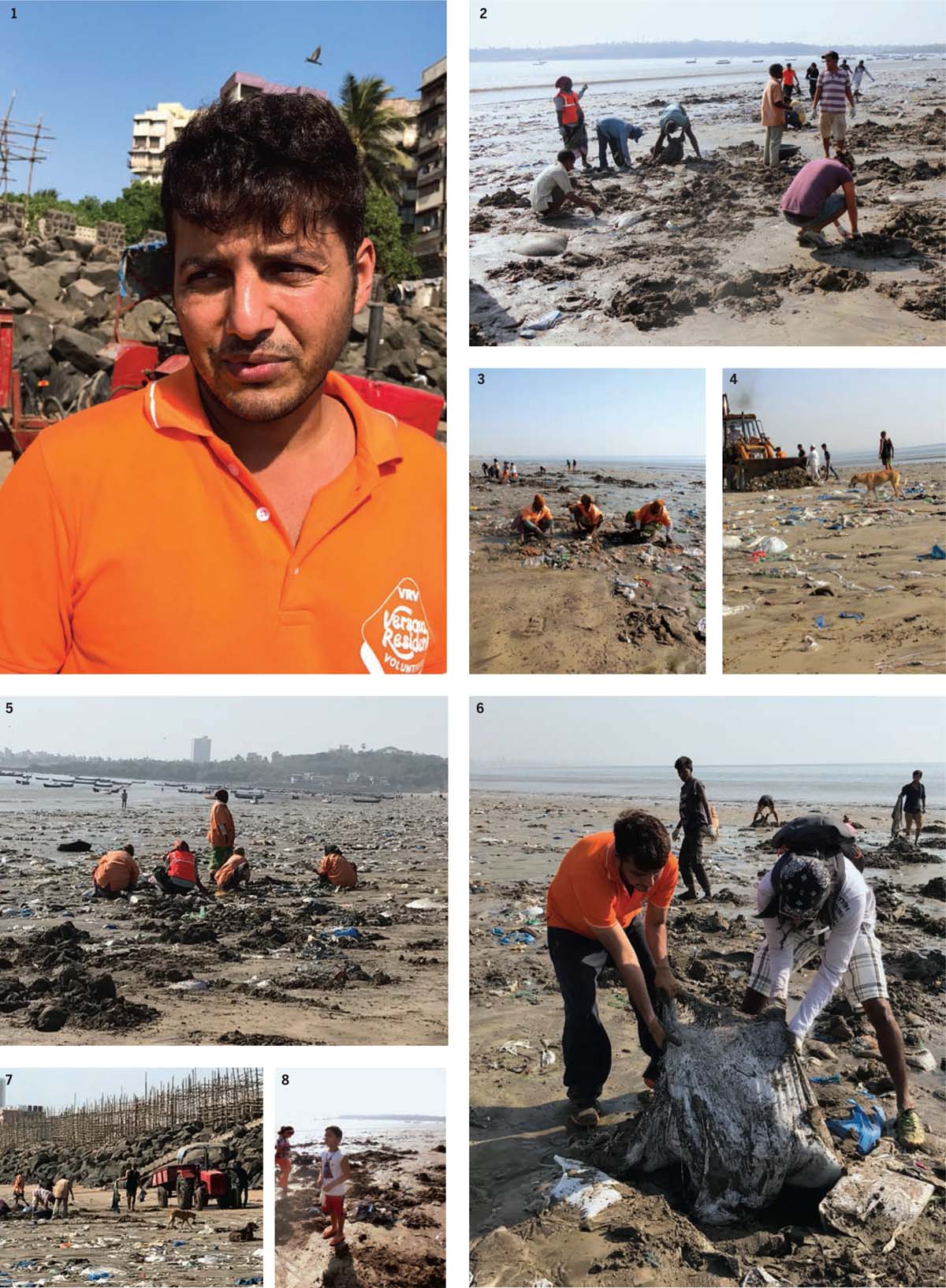
2. & 3. Volunteers & BMC workers picking up plastic
4. JCB tractor to dig the deeply embedded plastic
5. Fisher folk lending a hand
6. Construction debris in HDPE bags are the hardest to dislodge
7. BMC garbage tractor
8. A student volunteer
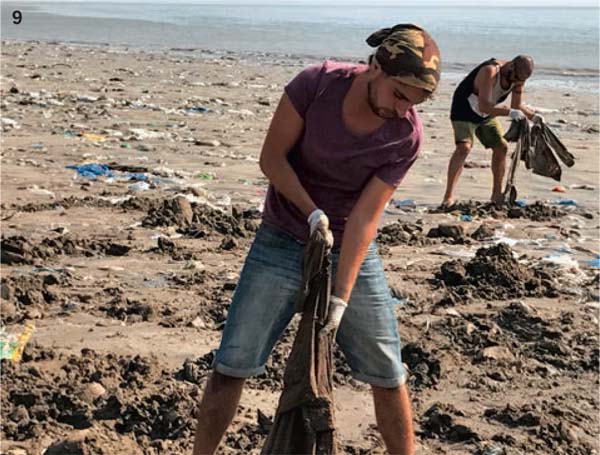 | 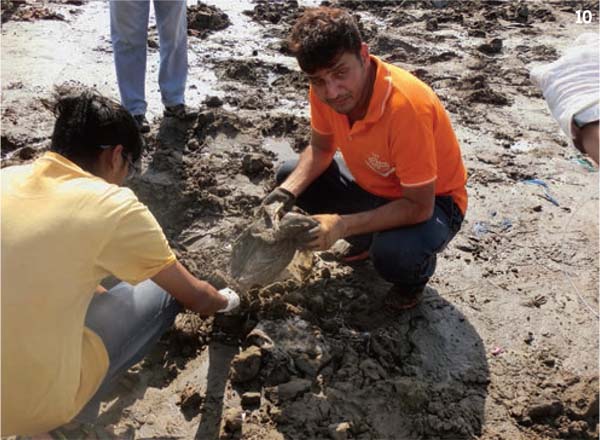 |
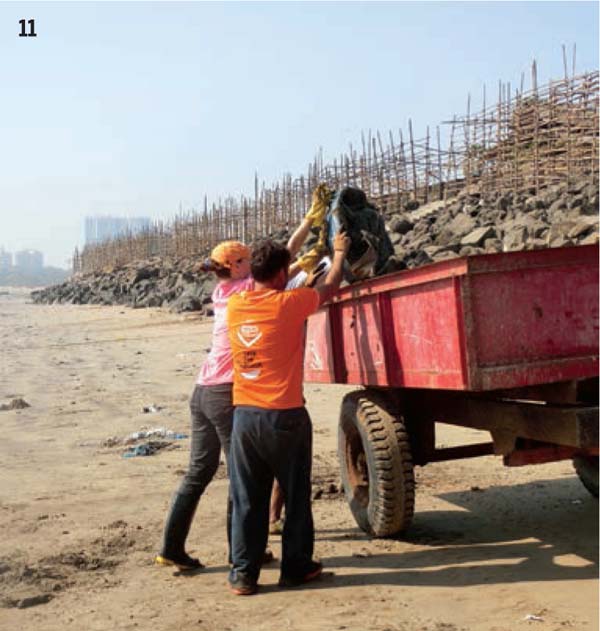 | |
The first time there was a low tide, Afroz came out to clean a patch of the beach that had layers of plastic bags filled with sand, milk packets, plastic detergent packets and a huge number of ready mix concrete bags. As he pointed to a far patch of land adjoining the nearby slum settlements along Versova Beach, he said, “That patch was cleaned up a few weeks ago with the help of a few volunteers, BMC workers, JCB tractors and my two hands.”
The Versova Beach has a slum at one end and a fisherman’s settlement on the other. The plush swanky apartment buildings along the beach beyond the high compound wall makes up the community that is immediately responsible for the cleanliness of the beach.
Afroz Shah, a resident of one of those sea-facing apartments, has been going to the slum settlements and cleaning up their toilets on a weekly basis in order to dissuade the slum dwellers from defecating in the open. He acknowledges the newly built toilets by the BMC in the area, but at the same time he thinks that they still require more facilities and daily maintenance. Also, the fishermen, along with Afroz, have swept the nallahs that open out into the ocean (which were earlier creeks and rivers) using fishing nets in order to collect floating plastic.
Drawing a reference to the Swachh Bharat Abhiyan he says, “It’s not only the officials, but also the citizens who need to have a sense of community and should step up and work with us.
Any person can write in a newspaper, appear on television and claim to change the world, but the issue is only resolved once its intricacies are understood and tackled on a personal and grass roots level.”
Having conducted the world’s largest beach clean up, Afroz Shah was bestowed with the Champions of the Earth Award. He believes that it does not require any NASA technology to conduct a beach clean-up, just a pair of gloves and a strong sense of community spirit. Afroz has removed 4300 tonnes of plastic and continues the work to keep his beach clean.
As the other volunteers help in clearing the patch of beach, not very far off, the fishermen come to the shores, sifting through the sand, picking the best lot of shellfish that has come afloat.
“There are 19 beaches in Mumbai. My job on this beach is done. It requires commitment and persistence to maintain these beaches. Volunteers from across the globe who have helped me through these weeks have now started a similar wave of beach clean ups in their respective countries. The volunteer from Singapore keeps in touch through Facebook and it’s heartening to know that my efforts are having an impact across the globe.”
With a twinkle in his eye and a winner’s attitude he invites everyone to join his campaign by following him on Facebook (Afroz Shah) and Twitter (@AfrozShah1) and humbly urges people to actively participate in the upcoming clean ups. “If not us, then who?” he asks, adding, “We can’t just keep waiting.”

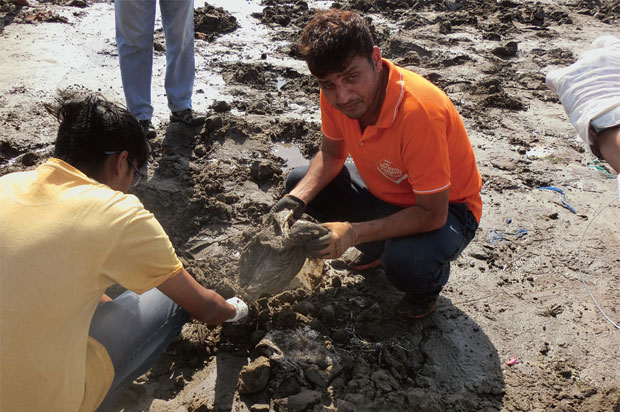

Comments (0)